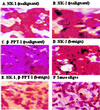Increased expression of preprotachykinin-I and neurokinin receptors in human breast cancer cells: implications for bone marrow metastasis
- PMID: 10618428
- PMCID: PMC26673
- DOI: 10.1073/pnas.97.1.388
Increased expression of preprotachykinin-I and neurokinin receptors in human breast cancer cells: implications for bone marrow metastasis
Abstract
Neuropeptides are implicated in many tumors, breast cancer (BC) included. Preprotachykinin-I (PPT-I) encodes multiple neuropeptides with pleiotropic functions such as neurotransmission, immune/hematopoietic modulation, angiogenesis, and mitogenesis. PPT-I is constitutively expressed in some tumors. In this study, we investigated a role for PPT-I and its receptors, neurokinin-1 (NK-1) and NK-2, in BC by using quantitative reverse transcription-PCR, ELISA, and in situ hybridization. Compared with normal mammary epithelial cells (n = 2) and benign breast biopsies (n = 21), BC cell lines (n = 7) and malignant breast biopsies (n = 25) showed increased expression of PPT-I and NK-1. NK-2 levels were high in normal and malignant cells. Specific NK-1 and NK-2 antagonists inhibited BC cell proliferation, suggesting autocrine and/or intercrine stimulation of BC cells by PPT-I peptides. NK-2 showed no effect on the proliferation of normal cells but mediated the proliferation of BC cells. Cytosolic extracts from malignant BC cells enhanced PPT-I translation whereas extracts from normal mammary epithelial cells caused no change. These enhancing effects may be protein-specific because a similar increase was observed for IL-6 translation and no effect was observed for IL-1alpha and stem cell factor. The data suggest that PPT-I peptides and their receptors may be important in BC development. Considering that PPT-I peptides are hematopoietic modulators, these results could be extended to understand early integration of BC cells in the bone marrow, a preferred site of metastasis. Molecular signaling transduced by PPT-I peptides and the mechanism that enhances translation of PPT-I mRNA could lead to innovative strategies for BC treatments and metastasis.
Figures


References
-
- Hagi K, Inaba K, Sakuta H, Maramatsu S. Blood. 1995;86:1316–1321. - PubMed
-
- Moore R N, Osmand A P, Dunn J A, Joshi J G, Rouse B T. J Immunol. 1988;141:2699–2703. - PubMed
-
- Mitchell B, Kendall M, Adam E, Schumacher U. J Neuroimmunol. 1997;75:19–27. - PubMed
-
- Payan D G. Annu Rev Med. 1989;40:341–352. - PubMed
-
- Rameshwar P. Clin Immunol Immunopathol. 1997;85:120–133. - PubMed
Publication types
MeSH terms
Substances
Grants and funding
LinkOut - more resources
Full Text Sources
Other Literature Sources
Medical

